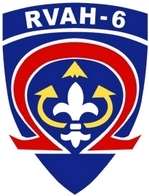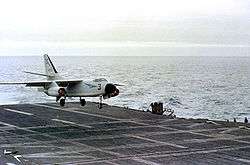RVAH-6
RVAH-6 was a Reconnaissance Attack (Heavy) Squadron of the U.S. Navy. Originally established as Composite Squadron Six (VC-6) on 6 January 1950, it was redesignated as Heavy Attack Squadron Six (VAH-6) on 1 July 1956 and was redesignated as Reconnaissance Attack (Heavy) Squadron Six (RVAH-6) on 23 September 1965. The squadron was disestablished on 20 October 1978.[1]
| Reconnaissance Attack (Heavy) Squadron 6 | |
|---|---|
 RVAH-6 squadron patch | |
| Active | 6 January 1950-20 October 1978 |
| Country | United States |
| Branch | United States Navy |
| Role | Photo-reconnaissance |
| Part of | Inactive |
| Nickname(s) | Fleurs |
| Engagements | Vietnam War |
Operational history
%2C_circa_in_1954.jpg)
_1956.jpg)

_c1972.jpg)
VC-6
VC-6 was established at NAS Moffett Field, California on 6 January 1950 as the Navy's second nuclear attack squadron and was initially equipped with the P2V Neptune. It became the second Navy squadron to operate the AJ-2 Savage, receiving its first aircraft in late 1950.[2] In June 1952, the squadron relocated to NAS North Island, California and was redesignated Heavy Attack Squadron SIX (VAH-6) on 1 July 1956.[3]
VAH-6
VAH-6 remained at NAS North Island until relocating to NAS Whidbey Island, Washington in early 1958. In June 1958, VAH-6 reequipped with the Douglas A3D-2 Skywarrior and made several Western Pacific (WESTPAC) deployments aboard USS Ranger and Mediterranean deployments aboard USS Forrestal.[4] The squadron's A3D-2 aircraft were redesignated as the A-3B Skywarrior in September 1962.
In 1965, the squadron relocated to NAS Sanford, Florida. In September 1965, the squadron completed transition to the RA-5C Vigilante and was redesignated as Reconnaissance Attack Squadron SIX (RVAH-6).[3]
RVAH-6 / Vietnam
- 12 May - 3 December 1966, RVAH-6 was embarked on USS Constellation for a WESTPAC and Vietnam deployment.[6]
- On 19 August 1966, RA-5C BuNo 149309 was lost in combat while flying from USS Constellation; both crewmen ejected successfully and were rescued.[7]
- On 23 October 1966, while operating from USS Constellation, RA-5C BuNo 150830 was lost in combat over North Vietnam.[7] The remains of the crew, LCDR Thomas Kolstad[8] and LTJG William Klenert,[9] were returned to the United States in March 1977. Kolstad was posthumously promoted to CDR and Klenert was posthumously promoted to LT and LCDR.[10]
- 4 November 1967 – 25 May 1968, RVAH-6 was embarked on USS Ranger for a WESTPAC and Vietnam deployment.[6]
- Budgetary pressures of the Vietnam War force the Department of Defense to close several stateside air bases, to include NAS Sanford, Florida. Upon return from their 1967-1968 deployment, RVAH-1 shifts home stations from NAS Sanford to the former Turner AFB, renamed Naval Air Station Albany, Georgia.
- 6 January-2 July 1969, RVAH-6 was embarked on USS Enterprise for a WESTPAC and Vietnam deployment.[6]
- On 31 March 1969, RA-5C BuNo 150842 was lost in combat over Laos with the RVAH-6 Commanding Officer, CDR Danforth White,[11] as the pilot and LT Ramey Carpenter[12] as the reconnaissance attack navigator. The aircraft burst into flames and broke up in flight; there were no ejections and both crewmen were killed in action.[7]
- 6 November 1970 – 17 July 1971, RVAH-6 was embarked on USS Kitty Hawk for a WESTPAC and Vietnam deployment.[6]
- 5 June 1972 – 24 March 1973, RVAH-6 was embarked on USS America for a WESTPAC and Vietnam deployment.[6]
RVAH-6 / Cold War
- 11 March 1974 - 11 September 1974, RVAH-6 was embarked on USS Forrestal for an Atlantic/Mediterranean deployment.
- Budgetary pressures following the end of the Vietnam War force the Department of Defense to again close several stateside air bases, to include NAS Albany, Georgia. Following completion of their 1974 deployment, RVAH-6 shifts home stations from NAS Albany to NAS Key West, Florida.[14]
- 21 May 1975 - 15 December 1975, RVAH-6 was embarked on USS Kitty Hawk for a WESTPAC deployment.[6]
- 1 December 1977 - 20 July 1978, RVAH-6 was embarked on USS Nimitz for an Atlantic/Mediterranean deployment.
Attrition of airframes and the increasing maintenance and flight hour costs of the RA-5C in a constrained defense budget environment forced the Navy to incrementally retire the RA-5C and sunset the RVAH community beginning in mid-1974. Carrier-based reconnaissance was concurrently conducted by the active duty VFP community at NAS Miramar and the Naval Reserve VFP community at Andrews AFB / NAF Washington with the RF-8G Crusader until 29 March 1987, when the last RF-8G is retired and the mission was fully transferred to the active duty and Naval Reserve VF community at NAS Miramar, NAS Oceana, NAS Dallas and NAS JRB Fort Worth as a secondary role with the F-14 Tomcat equipped with the Tactical Air Reconnaissance Pod System (TARPS).
Following its return from its final Atlantic/Mediterranean deployment in July 1978, RVAH-6 was inactivated at NAS Key West on 20 October 1978 following over 28 years of active service. One of RVAH-6's aircraft from its final deployment aboard Nimitz, BuNo 156624, was flown to NAS Pensacola, Florida as a permanent addition to the collection of the National Naval Aviation Museum.
Home station assignments
The squadron was assigned to these home stations:
- NAS Moffett Field, California
- NAS North Island, California
- NAS Whidbey Island, Washington
- NAS Sanford, Florida
- NAS Albany, Georgia
- NAS Key West, Florida
Aircraft Assigned
See also
References
- Grossnick, Roy A. (1995). Dictionary of American Naval Aviation Squadrons Volume 1 The History of VA, VAH, VAK, VAL, VAP and VFA Squadrons. Washington, D.C.: Naval Historical Center, Department of the Navy. p. 547. Retrieved 29 December 2015.
- Ginter, Steve (1992). North American AJ-1 Savage (Naval Fighters Number 22). p. 77. ISBN 0942612221.
- http://www.a3skywarrior.com/ready-room/a-3-squadron-history.html
- "Skywarrior in Service with US Navy". Joe Baugher. Retrieved 29 December 2015.
- "Carrier, Carrier Based Squadrons and Non-Carrier Based Squadron Deployments to Vietnam" (PDF). Washington, D.C.: Naval Historical Center, Department of the Navy. 1995. Retrieved 30 December 2015.
- Powell, Robert (2012). RA-5C Vigilante Units in Combat. Osprey Publishing. p. 86. ISBN 9781782005421.
- http://www.virtualwall.org/dk/KolstadTC01a.htm
- http://www.virtualwall.org/dk/KlenertWB01a.htm
- "U.S. Accounted-For from the Vietnam War (Sorted by Name) Prisoners of War, Escapees, Returnees and Remains Recovered" (PDF). Defense POW/MIA Accounting Agency. Retrieved 30 December 2015.
- http://www.virtualwall.org/dw/WhiteDE01a.htm
- http://www.virtualwall.org/dc/CarpenterRL01a.htm
- http://www.gonavy.jp/navy/sqn/VAH01.html
